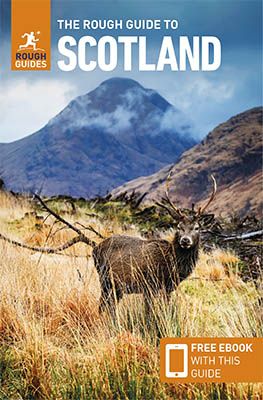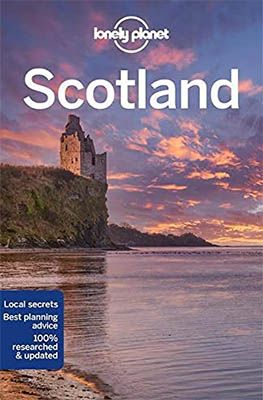On the border of the Scottish Lowlands and Highlands lies the country’s first national park: Loch Lomond & The Trossachs. The area has plenty of beautiful lakes and imposing mountains. Therefore, it is a great destination if, like us, you love hiking. We enjoyed two wonderful hikes in the national park from our base at Callander. Besides hiking, the national park offers many other outdoor opportunities. Let’s take a closer look at the beautiful Loch Lomond & The Trossachs National Park in this blog.
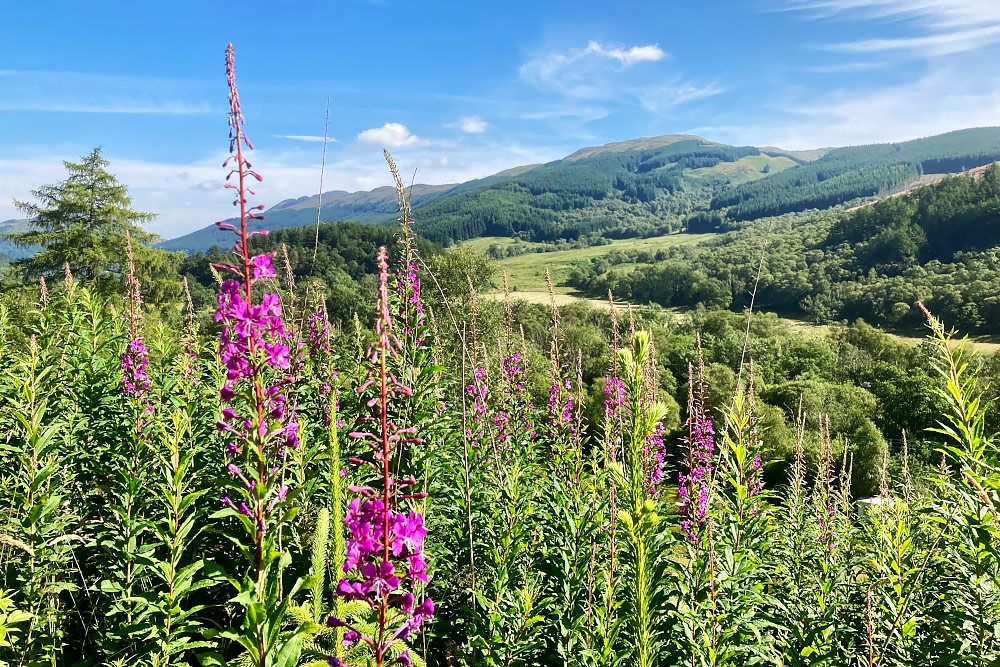
Lochs in Loch Lomond & The Trossachs
There are 22 lochs (lakes) in the national park. Loch Lomond is the most famous of these. This is the largest lake in Scotland, both in area and water content. In some places, the lake is almost 200 metres deep. There are 22 islets in the lake. Most of these are privately owned. The island of Inchcailloch, however, is accessible. This is a wonderful place to enjoy nature in peace.
On the western shore of Loch Lomond lies the picturesque village of Luss. According to the local tourist office, it is the prettiest village in all of Scotland. We wouldn’t dare say so, but it’s certainly fun to spend an hour walking through the town. The streets are lined with characteristic sandstone and slate cottages. The many roses and other flowers make for a colourful sight. Bear in mind that the town receives many day trippers every day. So, you won’t walk through Luss alone.
Another beautiful lake is Loch Katrine. The lake inspired the famous Scottish writer Sir Walter Scott to write his novel “The Lady and the Lake”. The lake is somewhat less touristy than Loch Lomond. Still, plenty of people come because a boat trip on the famous steamship Sir Walter Scott is something many want to experience.
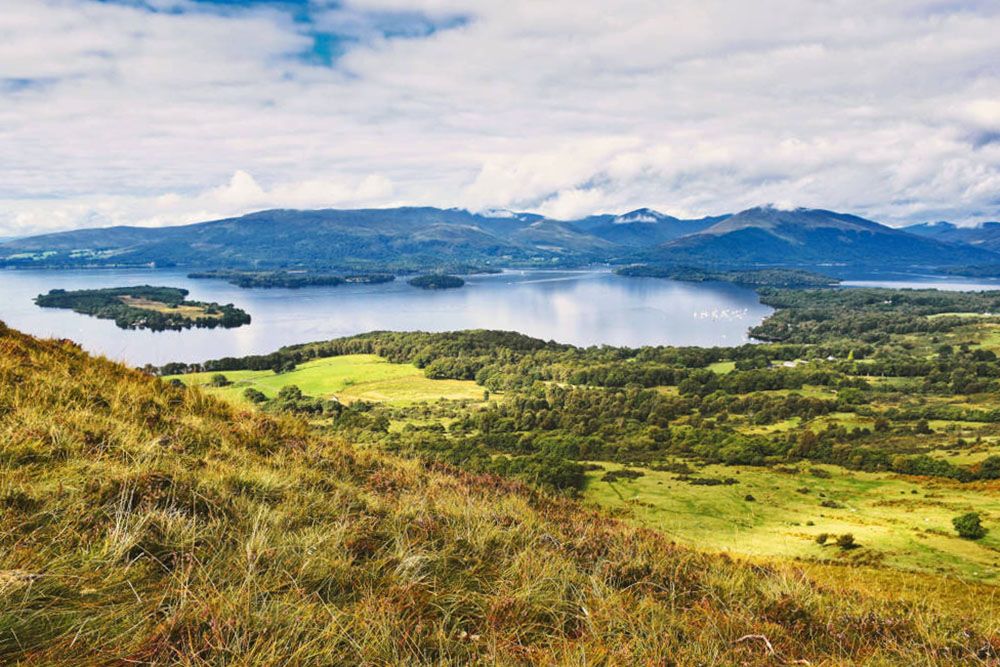
Munros in Loch Lomond & The Trossachs
The National Park is where the Scottish Highlands begin. It is a beautiful hilly area with 21 munros (mountains) higher than 3000 ft. Ben More is the highest. Ben Lomond is Scotland’s southernmost mountain. There are also plenty of mountains that are just a little less high and therefore not called munros. These mountains are called corbetts. The best known are The Cobbler and Ben Ledi. Among hikers, the munros and corbetts are sought after not only because of the sporting challenge, but also because of the beautiful view of the surroundings from the summit.
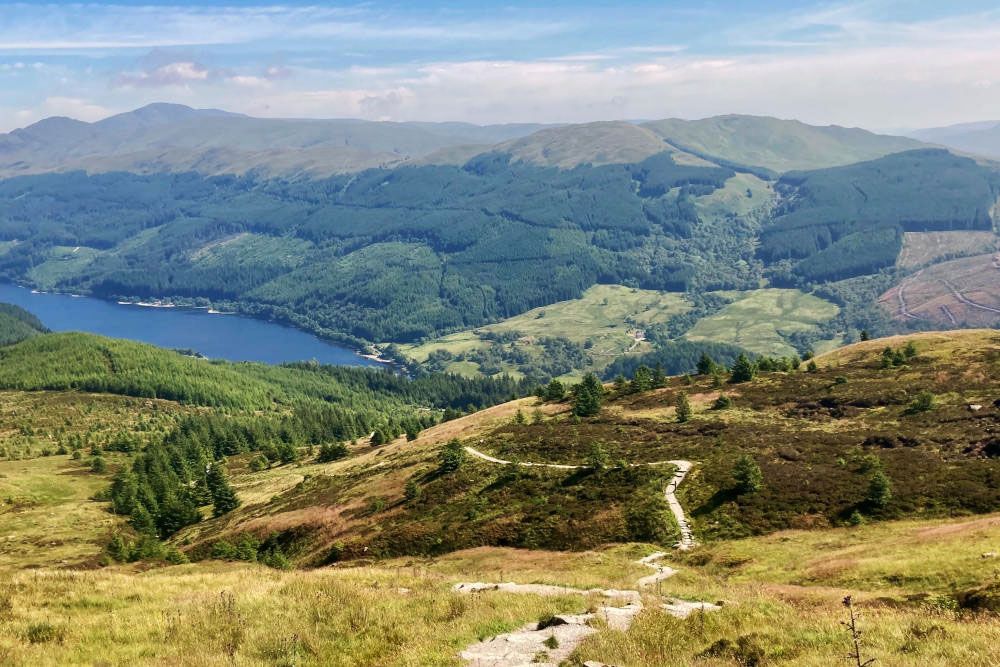
Our walks in Loch Lomond & The Trossachs
From our base at Callander, we took two beautiful hikes in the area.
Hiking at Glen Finglas
For the first day, we immediately choose a big trek of about 27 kilometres. This long and hilly route takes us past the Glen Finglas Reservoir. We then slowly ascend to arrive at Meall Cala, the highest point at almost 600 metres. We then descend back to the valley.
The Glen Finglas visitor centre is the starting point of our route. We get there early, but fortunately it is already open. We are told that we have chosen a beautiful, but due to its length a challenging walk. The staff member also tells us that the route is well marked. Lucky, because then we don’t have to look at our phones all the time to check the GPS track.
The first stretch we walk through forests with rushing streams. Then we reach the Glen Finglas Reservoir. On the banks of the lake, a young couple is just taking down their tent. They have spent the night there and will soon move on to another place to camp in the wild. For now, they are the last people we encounter. Only hours later, a mountain biker approaches us who had made the round trip by bike.
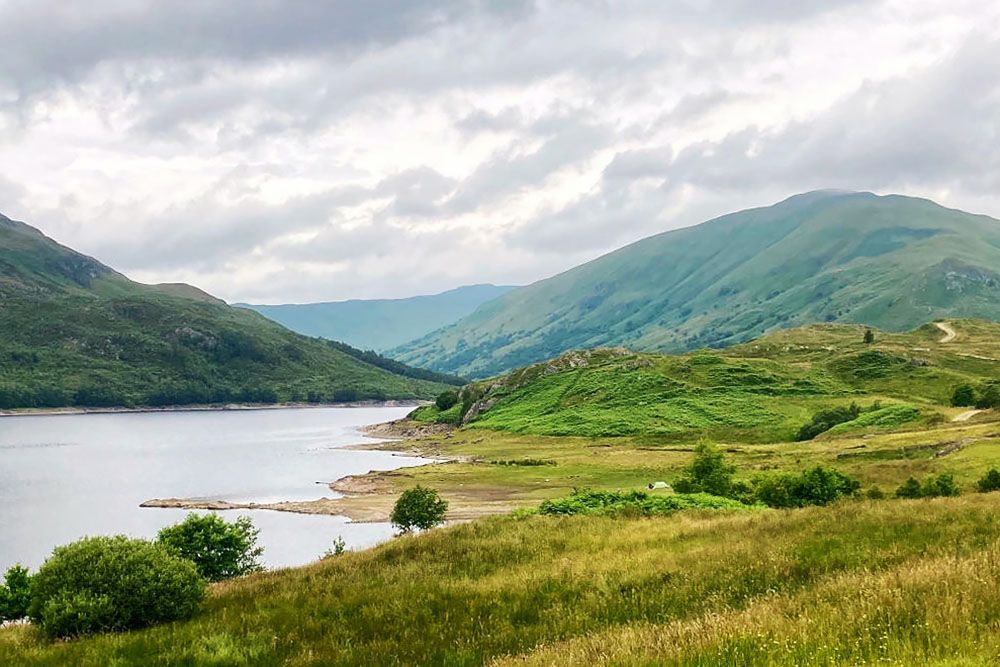
Goat and cow
At the end of the lake, keep right. From now on, the path starts to rise gradually. Fortunately, the path is nice and wide and easy to walk on. At every bend, the view is different. A curious goat happily poses for us on a small hill. With the lake and hills in the background, it’s a pretty picture.
Halfway along the route, an immense cow lies on the path. We have never seen such a large cow. She hasn’t noticed us yet, yet we hesitate whether we would be wise to walk past her briefly. But the only alternative is to walk the same route back. We don’t feel like doing that, so we carefully shuffle past the beast. The cow is fine with it all and lies quietly down.
From the highest point, we enjoy the wonderful view once more. Then we start the descent. Fortunately, thanks to the gently sloping path, it is very manageable and not stressful for our knees. The last bit we walk the same way as on the outward journey along the lake. Then we choose a different colour-marked route to reach the visitor centre by a different route. In total, we walked about 27 kilometres. Satisfied, we rested for a while at the visitor centre. This walk at Glen Finglas was long, but definitely worth it!
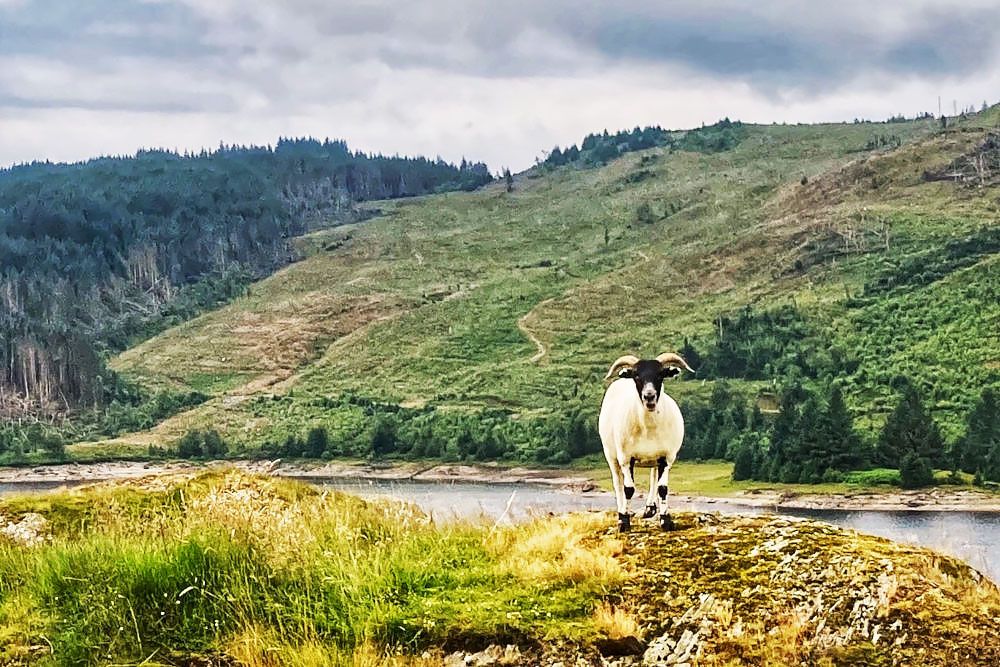
To the Ben Ledi
At just under 900 metres, Ben Ledi is the highest peak near Callander. The walk to the summit is our goal. Although it is a popular walk, we don’t meet many other hikers. That can also sometimes be a disadvantage….
From the small car park, we head straight up the hill path. The first part goes through the forest on a well-trodden path. The path keeps going up gradually, there is no descending. We can see the Lowlands in the distance, like our starting point Callander and Loch Lubnaig.
The climb heads towards the south side of Ben Ledi. The views get more and more beautiful. It is a clear day. We can even see Stirling far ahead, with the Wallace monument and the magnificent castle as beacons. The wide ridge takes us to the top of Ben Ledi. Every time we think we are at the top, we descend again and have to cross another hill. Then we see the iron cross at the top. It is a memorial to a member of the Mountain Rescue Team who died while working years ago.
At the cross, we meet some Scottish hikers. They live nearby and regularly walk to the top of the mountain. “Be careful later when you go down, the route is hard to find,” warns one of them before they continue. We take our lunch break at this spot and stay a while longer. In no time, we are alone again.
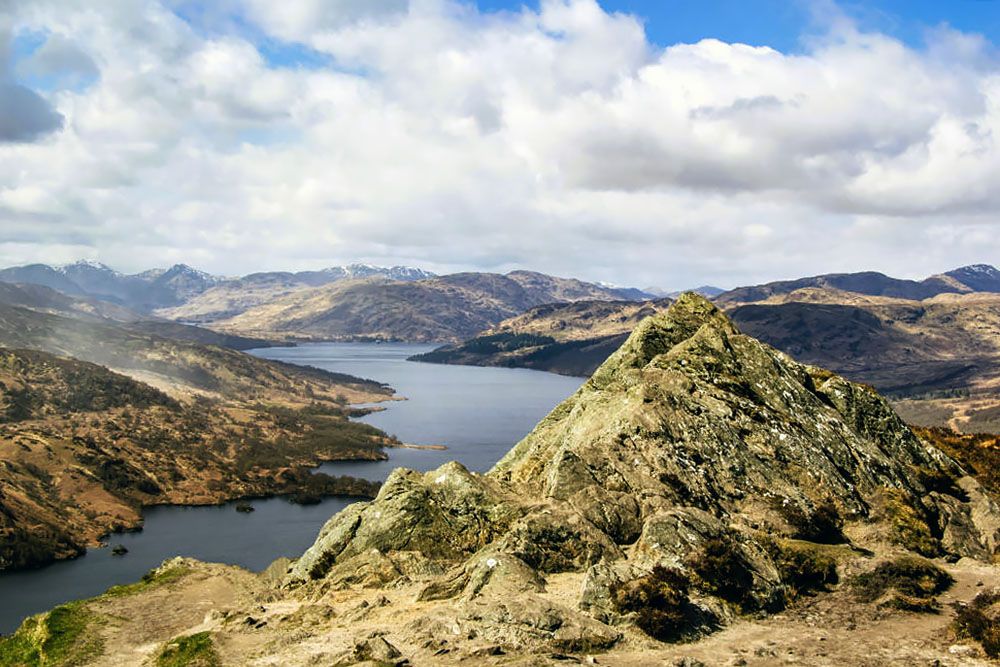
Tracking
Indeed, despite our GPS track, getting back will be tricky. There is no path and we meander through the tall and sometimes boggy grass. We stay reasonably close to our line on the phone, so we should be fine. Still, too bad we didn’t go after the other hikers right away. Fortunately, after a while we rejoin a path by a stream. After a while, we reach a T-junction with directions to the car park. The paths are again wide and easy on this stretch. When we hear some rustling in the bushes, a roe deer suddenly shoots across the path, clearly startled by our voices. We continue walking along the river and, after a while, reach our parking place again.
It was a fine walk with beautiful views. Despite the tricky return route, we are glad we did this walk to the Ben Ledi in Loch Lomond & The Trossachs.
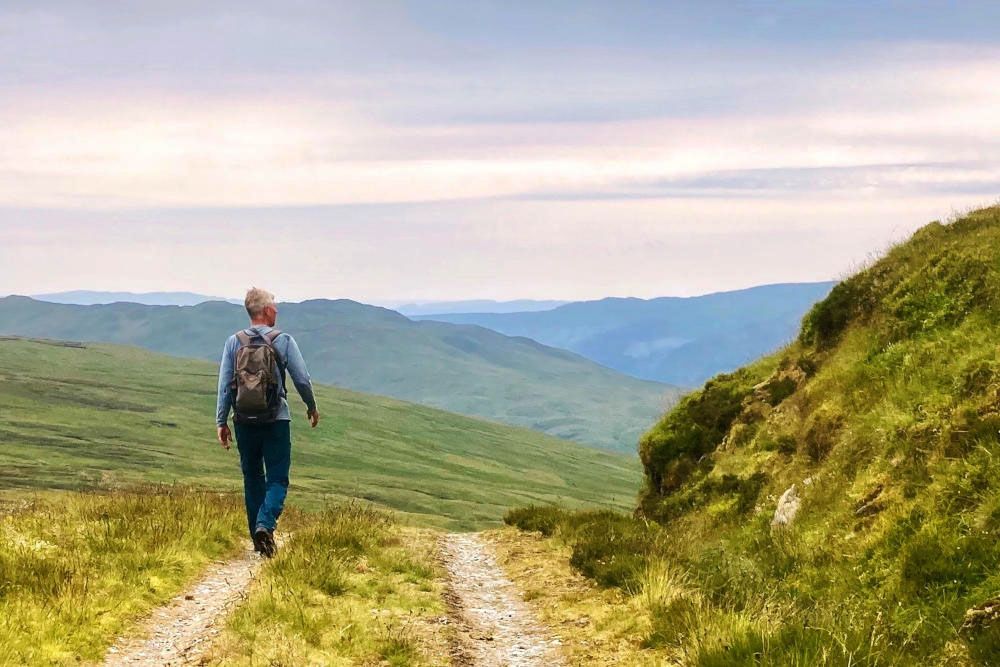
Other hiking opportunities in Loch Lomond & The Trossachs
Unfortunately, of the many walks in the park itself, we could only do two. This is certainly a shame, as the park is a hiker’s paradise. Whether you like easy walks or prefer challenging multi-day treks, there is plenty of choice for every level.
We got our inspiration from VisitScotland’s various information offices (called iCentres). You can find these in Balloch, Tarbet, Aberfoyle and Callander. In addition, the Walk Highlands website is a perfect resource. With each walk, you’ll find an excellent description of the route, a map and a GPS track.
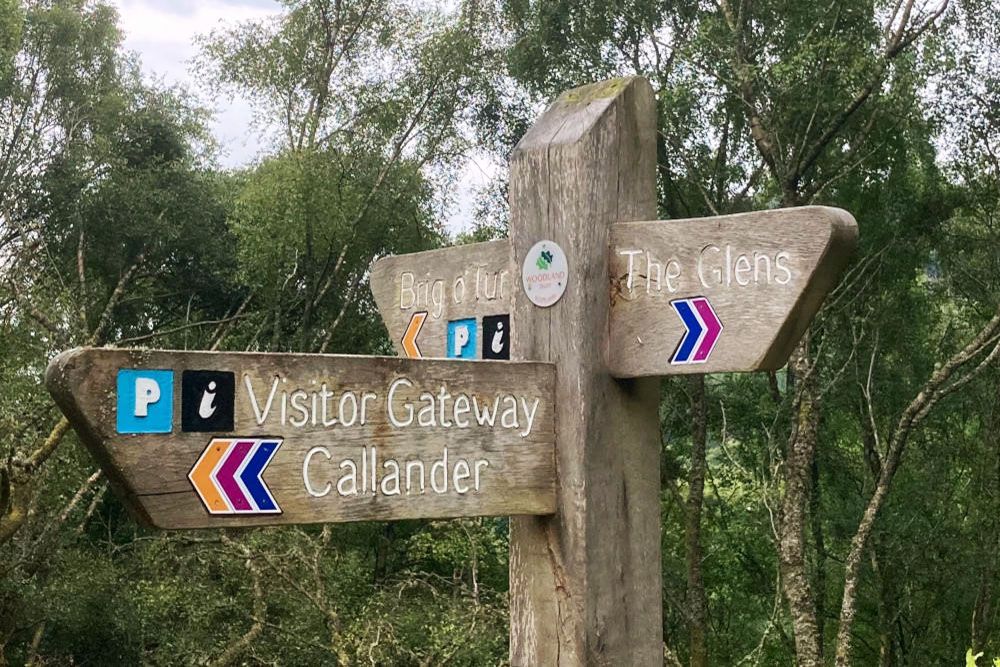
Further outdoor opportunities in Loch Lomond & The Trossachs
The national park is a great area for more than just hikers. Fans of other activities can also have fun there.
Watersport
Especially on the largest lake, Loch Lomond, all forms of water sports take place. Sailing, canoeing, kayaking, swimming, supping, windsurfing, we have seen it all at this lake.
If you are a beginner and want to go canoeing or kayaking, do so in Loch Lubnaig. This lake is just south of Strathyre. No motorised water sports take place there. Besides, the lake’s sheltered location makes for ideal conditions. So, you have plenty of time to enjoy the peace and quiet on one of the most beautiful lochs in the park.
Cycling & Mountain biking
Although the national park has numerous mountains, there are plenty of cycling routes available for every level of ability. There are also great routes for mountain bikers, from easy to challenging. You will see the heart of the national park during part of the National Cycle Network Route 7. This takes you past the most beautiful spots of the park. All information on cycling routes in Loch Lomond & The Trossachs.
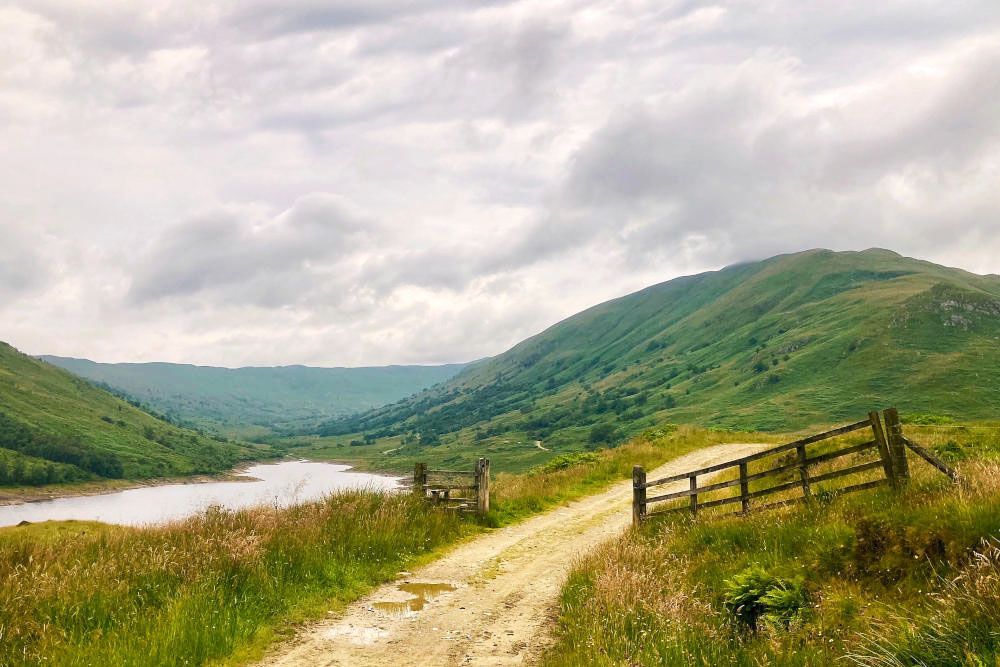
Fishing
With 22 lakes, the park is an eldorado for anglers. At every lake we passed, we saw anglers on the shore staring at their floats. On the water, people were also fishing in many boats. Fly-fishing was also being done at several places. Fishing does require a fishing licence. You can obtain these from various addresses. Staff at the Scottish Tourist Offices can provide you with a list.
Golf
Scotland is “home of golf”. Not surprisingly, you can tee off at several places in the park. There are seven courses in total, some have 9 holes, others 18. Without exception, the views on all courses are spectacular. The Aberfoyle course, for instance, lies at the foot of the imposing Ben Lomond. From the golf course in Callander, you have fine views of the Ben Ledi. This is the overview of golf courses in Loch Lomond & The Trossachs.
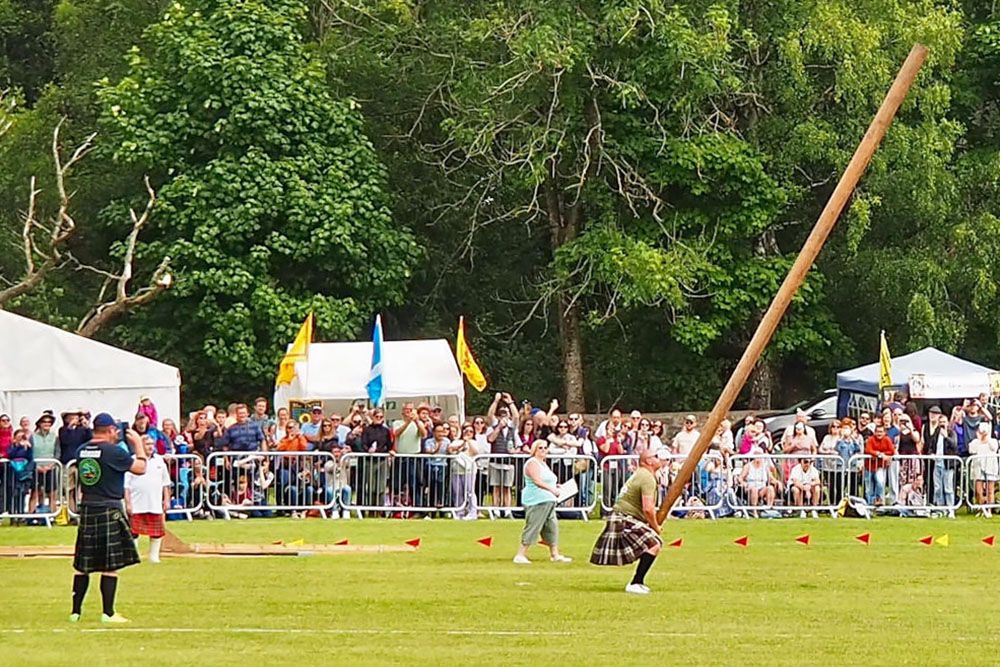
Highland Games in Balloch
One of Scotland’s many age-old traditions is the Highland Games. These games take place every year in a large number of places during the months of July to September. Each town organises its own unique Highland Games over the course of a day. Well-known items include pole throwing, tug-of-war and hammer swinging. All this is accompanied by – how could it be otherwise – bagpipe music.
We were in Balloch when the Highland Games took place there. We wanted to experience that. We feasted our eyes. It is fascinating to see how participants and audience completely indulge in these traditions that are important to them. Men are dressed in kilt, children do dance competitions and the audience makes a nice day out of it: bring chairs, sit along the side and enjoy this special folklore. That’s why we definitely recommend you to experience a day of the Highland Games. It can be done in plenty of places in Scotland. For that, check the VisitScotland iCentres for the calendar of events.
For us, the Highland Games were the conclusion of several active days in Loch Lomond & The Trossachs National Park. It was a welcome change from the days walking in the park’s beautiful countryside. And so, we were intimately introduced to a typical example of Scottish intangible heritage.
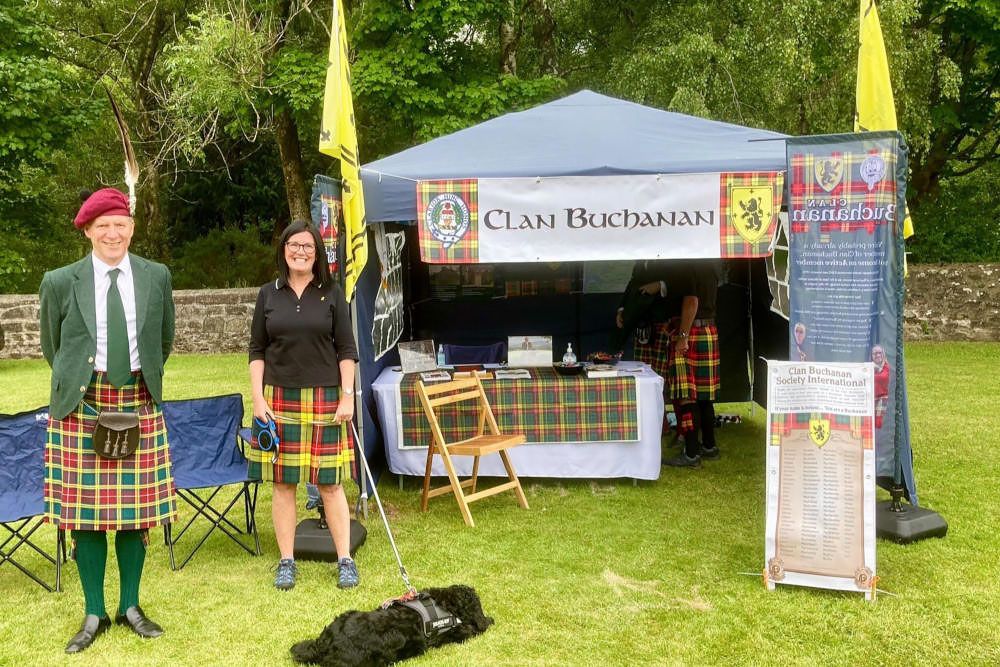
Frequently asked questions about Loch Lomond & The Trossachs
Scotland's first national park lies on the border of the Scottish Lowlands and Highlands. The southern part of the park is about a 45-minute drive northwest of Glasgow. The northern end of the park is near the town of Tyndrum. From that town, it is just over an hour's drive to north Fort William.
You can reach the park very easily by both car and train. Most holidaymakers will visit Scotland with their own car or motorhome. From Glasgow, it is a 45-minute drive to Balloch, on the south side of the park.
From Glasgow, you can also take the train. This stops in Balloch. The famous West Highlands Line also passes the park. It stops in Arrochar, Tarbet, Crianlarich and Tyndrum, among others.
Absolutely! There are countless hikes available throughout the park. These vary in length and difficulty, so there are some hikes for every level of ability. In addition to many day hikes, there are also multi-day hikes available. The perfect source of information for finding a walk in the national park is the Walk Highlands website.
These places are ideal to use as a base when exploring the national park:
- Balloch (VisitScotland iCentre present)
- Balmaha (Park Visitor Centre present)
- Aberfoyle (VisitScotland iCentre present)
- Callander (VisitScotland iCentre present)
- Strathyre
- Killin
- Tyndrum (VisitScotland iCentre present in high season only)
- Tarbet (VisitScotland iCentre present in high season only)
We made great use of the expertise of the VisitScotland Centres staff. They know the area like the back of their hand, know the best walks and attractions and are happy to inform you to make your stay as pleasant as possible.
Wild camping is allowed throughout the park. However, there are special Camping Management Zones. These require a permit in the high season. More information on camping in the park can be found on this website.
Prefer to sleep in a comfortable bed in a cottage, guest house or hotel? Then this is the list of available accommodation in the main towns in the park:

